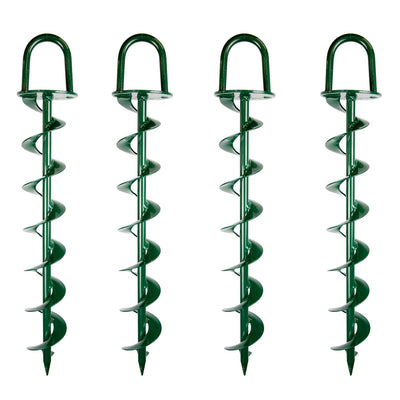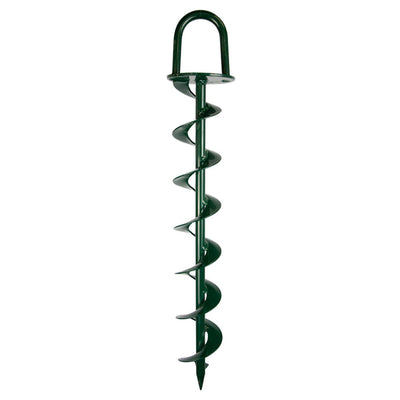Why a Secure Ground Anchor Matters for Trailers
Check Out the Various Kinds Of Ground Support for Your Following Job
When embarking on a construction or landscape design task, recognizing the various kinds of ground anchors readily available is essential to making certain both stability and resilience (Ground Anchor). From auger anchors, which stand out in diverse dirt problems, to risk supports developed for short-lived installations, the choices are many. In addition, concrete and screw supports present special benefits in particular circumstances, while deadman supports are customized for applications calling for resistance to lateral forces. The selection of a proper support type can significantly affect the total success of your task, prompting additional exploration right into their respective benefits and applications.

Auger Anchors
Auger anchors are a preferred selection in different building and construction and landscape design projects because of their special design and reliable securing capabilities. These supports are composed of a helical screw-like shaft that is driven right into the ground, permitting a secure and secure hold. The spiral layout promotes very easy installment and takes full advantage of resistance versus lateral pressures, making auger anchors especially efficient in applications such as secure fencing, short-term frameworks, and disintegration control.
The setup procedure of auger supports is relatively straightforward. They can be manually or mechanically mounted, relying on the size and needed depth. This versatility permits their usage in varied dirt conditions, from sandy to clayey surfaces. Furthermore, auger supports can be conveniently eliminated and recycled, which includes in their cost-effectiveness and sustainability.
One of the significant benefits of auger anchors is their ability to disperse lots uniformly across the surrounding dirt, decreasing the risk of soil disruption and minimizing environmental impact. In addition, they are much less susceptible to heaving or loosening gradually compared to traditional anchoring techniques. Subsequently, auger anchors are an outstanding option for projects calling for long lasting and reliable anchoring options.

Stake Anchors
When it comes to safeguarding frameworks in a selection of outdoor applications, risk anchors use a uncomplicated and dependable option. These supports are generally created from long lasting products such as steel or light weight aluminum, designed to withstand ecological stress and anxieties while offering ideal stability. Their simple layout allows for quick installation, making them a perfect choice for temporary or permanent anchoring demands.
Risk anchors are particularly helpful in protecting camping tents, canopies, and various other light-weight structures versus wind and weather. They function by being driven into the ground at an angle, creating a strong hold that resists pull-out pressures - Ground Anchor. The efficiency of risk supports relies on a number of aspects, consisting of soil type, moisture material, and the angle of installment
For added security, several stake anchors come with attachment factors for straps or ropes, enabling for stress modifications as needed. In applications such as landscaping or building, they can effectively stabilize tools or frameworks on unequal terrain. On the whole, stake anchors provide a cost-effective and versatile solution for safeguarding various outdoor setups, making them a recommended option for contractors and DIY lovers alike.
Concrete Anchors
Concrete supports offer a robust service for protecting structures to concrete surfaces, making sure security and security in various applications. These anchors are necessary for jobs varying from household buildings to large-scale commercial installments. They come in different kinds, consisting of expansion anchors, adhesive anchors, and undercut supports, each created for details tons needs and ecological problems.
When mounted,Expansion supports rely on mechanical mechanisms to hold the concrete. They are suitable for tool to sturdy applications. Sticky supports utilize high-strength epoxy or material to bond the anchor to the concrete, offering remarkable load-bearing capabilities, especially in cracked concrete scenarios. Undercut supports develop an unique shape within the concrete, giving exceptional holding power, specifically in applications where tensile tons prevail.
When executed correctly, concrete anchors dramatically boost the architectural integrity of different projects, making them important in modern-day building and construction techniques. Understanding the specific demands of your project will certainly assist in picking the right type of concrete anchor for the job.
Screw Anchors

Screw anchors are a versatile securing option that can be properly employed in a selection of applications where standard concrete anchors may not be adequate. These supports contain a helical go to the website layout that allows them to be conveniently driven right into the ground, making them excellent for use in dirt and other substratums. Their unique structure supplies outstanding holding power and resistance to pull-out pressures, making them appropriate for countless tasks, from landscaping to architectural support.
One of the main advantages of screw supports is their convenience of installment. They need marginal tools and can often be installed without the need for excavation, which conserves both time and labor expenses. Furthermore, screw supports can be gotten rid of and reused, using a lasting remedy for temporary applications.
Screw anchors are particularly useful in locations where soil problems are testing, such as sandy or loosened dirts. Their ability to be installed at varying midsts permits for modification based on particular task demands. Overall, screw supports supply a effective and trustworthy anchoring method, making them an exceptional selection for specialists and designers seeking effective solutions for their projects.
Deadman Anchors
Deadman supports act as a robust option for maintaining frameworks in tough problems, particularly where standard securing approaches might drop brief. These supports include huge, hefty objects buried underground, which create resistance versus lateral pressures. The design commonly entails a straight part, such as a block of concrete or a metal plate, hidden in the soil, to which cables or bands are connected.
The effectiveness of deadman supports exists in their ability to distribute lots over a bigger location, lowering the threat of failure in unpredictable dirt problems. They are specifically useful in applications such as maintaining wall surfaces, short-term frameworks, and incline stablizing, where dirt movement can jeopardize the integrity of the framework.
Installation of deadman anchors calls for cautious preparation to guarantee they are positioned at the proper deepness and positioning, optimizing their load-bearing capacity. While they might call for more labor and product than light-weight supports, their dependability in unfavorable conditions makes them vital for long-lasting jobs. Deadman anchors are versatile and can be adjusted to various applications, making them a best option for designers encountering special challenges in their projects.
Final Thought
Auger supports excel in varied soil problems, while risk anchors match momentary applications. For concrete surfaces, expansion basics and sticky anchors Related Site give reliable options, and screw anchors provide convenience in tough terrains.
In addition, concrete and screw anchors existing special advantages in details situations, while deadman supports are customized for applications requiring resistance to side pressures - Ground Anchor.Auger supports are a popular option in numerous construction and landscaping tasks due to their distinct layout and reliable anchoring capacities. They come in different kinds, consisting of expansion anchors, sticky anchors, and undercut supports, each designed for particular tons demands and ecological problems
Glue supports make use of high-strength epoxy or resin to bond the anchor to the concrete, supplying remarkable load-bearing abilities, particularly in split concrete circumstances. In general, screw supports provide a dependable and effective securing technique, making them an excellent selection for designers and specialists seeking effective remedies for their tasks.